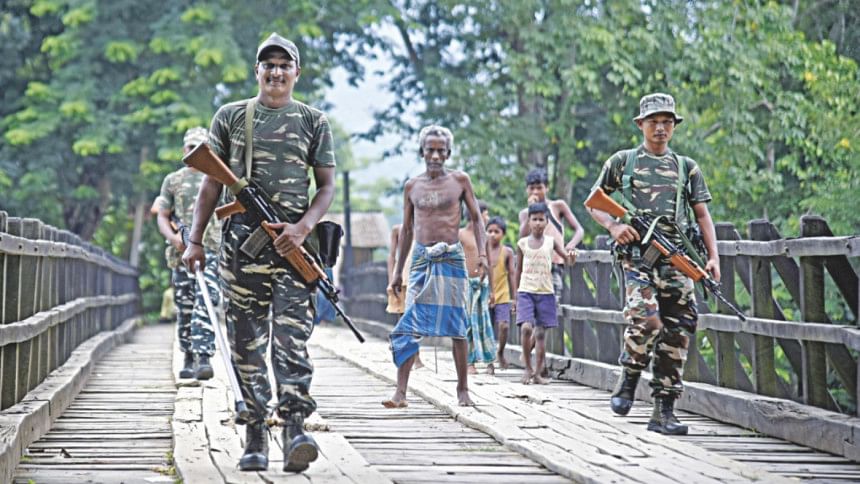NRC and the larger crisis brewing in Assam

Ecent developments surrounding the controversial National Registry of Citizens (NRC) in Assam have made many extremely worried across borders in Bangladesh and India regarding the future of Bengali Muslim settlers and Hindus alike. At risk are nearly 20 million people, including an estimated 12 million Hindus, who have been wrongfully left out of the NRC list announced in August 2019, setting off a huge political outcry in Assam, West Bengal and the rest of India. The Assamese nationalists, who advocated the updating of the NRC, expressed their indignity with the outcome and accused the state government of failing to provide indigenous Assamese people a "foreigner-free NRC."
The NRC exercise was conducted under the instruction of the Supreme Court of India in view of the demands by the All Assam Students' Union (AASU) and as per the Citizenship Act (1955) to identify and weed out illegal "foreigners" living in Assam. The Bharatiya Janata Party (BJP), which won the state election in Assam in 2016, was strongly behind the NRC with forthright use of their party slogan—jati, mati, bheti (home, hearth and identity)—urging people to protect the land from "illegal" Muslim migrants from Bangladesh. The final citizens' list, which excluded many indigenous and Hindu communities, suddenly made millions stateless in their own country. As a result, the BJP in Assam was put on the spot for creating a nightmarish mess with potential for deportation of a large number of native people. At the same time, the list disenfranchised the Bengali Muslim settlers—who lived in Assam for generations with rights to property, and other social, economic and democratic rights—as "infiltrators" and "illegal migrants", throwing their lives into disarray, along with migrants from Myanmar which borders four northeastern states of India.
The NRC outcome plunged Assam into chaos and did not satisfy anyone either in Assam or India. It targeted the minorities living in poverty—mostly Bengali speaking Hindus and Muslims in Assam, who are easily stereotyped as "Bangladeshis." To understand the complexity behind this crisis, it is vitally important to look back into the history and the social formation of the larger Assamese society and culture. The Indian Censuses (1911 to 1931) confirm steady migration of Bengali Muslim settlers from East Bengal to Assam, reportedly encouraged by the British to expand the agricultural frontier of this otherwise thinly populated state for more revenue generation. According to the census reports, the poor peasants from Mymensingh, Rangpur and Jalpaiguri gradually settled down in various parts of the state, especially in the Brahmaputra Valley. The Bengali settlers, therefore, have been part of the Assamese polity and culture for over 150 years as a legacy of past migration. Even today, the mobility of people for livelihood and other opportunities, including displacement by disasters, are constant within the region. As a result, it is not surprising to find today climate migrants moving across borders between Bangladesh, India and Myanmar. Attempts to control borders and boundaries are a relatively recent phenomena caused by political and security considerations.
The first organised campaign against the Bengali settlers in undivided Assam—the Bangal Khedao movement—dates back to 1940s in the Brahmaputra Valley and continued through 1960s, which ultimately led to the expulsion of 50,000 Bengali Hindus who took shelter in West Bengal. No comparable figures are available for Bengali Muslims who moved to East Bengal at that time. The "Assam for Assamese" movement in the 1970s and 1980s witnessed discrimination, killings and attacks on Bengali settlements, more particularly the migrant Bengali Muslims. In 1980, a Bengali legislator was killed and Bengali settlers' localities repeatedly came under systematic attacks. In 1983, more than 2,000 Muslims of Bengali origin were killed in just six hours during the infamous Nellie Massacre. In sum, the settlers became a common target of hate for the Assamese rioters: "if you see a snake and a Bengali, kill the Bengali first." The long turmoil named the Assam Movement (1979-1985) eventually led to the Assam Accord (1985), followed by the Supreme Court instruction for the NRC exercise.
As the NRC was in progress, many human rights experts raised concern over the drive against the "illegal" Bengali Muslim settlers for whom Assam remains their only home. This is echoed very eloquently in the writings of a group of Muslim poets of Bengali origin, pejoratively called "Miyah"—a term they have reclaimed now. The Miyah poetry began in 2016 at the height of the NRC controversy opposing the use of the word Miyah as a slang for Assamese Muslims of Bengali origin. The Miyah poetry essentially highlights links between language, identity and politics. The poems describe the humiliation and discrimination and capture a lifetime of oppression and abuse experienced by the settlers and their descendants in Assam. In July 2019, Assamese police booked 10 Miyah poets and activists under the India Panel Code for their writings on the NRC, which the Miyah poets condemned as baseless and wilful misreading of the poems. The anger against the Miyah poetry must be seen against the backdrop of Assamese politics for the last four to five decades—who is "native" to the state and who is an "outsider."
The citizens list has already made millions stateless, created huge uncertainty for those affected—who fear for their jobs, lands, access to healthcare, education for their children—and above all, the risk of deportation. To deal with the domino effects, the BJP Cabinet last week approved a Citizenship Amendment Bill (CAB) to be tabled soon in parliament; the CAB seeks to provide citizenship to persecuted religious groups such as Hindus, Sikhs, Parsis, Jains, Christians, Buddhists and other minorities from Bangladesh, Pakistan and Afghanistan, but not to Muslims. BJP hopes to use the CAB to counter the perception of fear about any future Pan-India NRC. In the process, BJP wants to make the Muslims second class citizens in India.
The impacts of the NRC and the CAB are already being felt at the Bangladesh borders. The domestic "political intrigues" of BJP and the possibility of a Pan-India NRC in the future may likely lead to a Rohingya-type migration to Bangladesh. Indeed, according to some reports, it has already started.
While Mamata Banerjee, the Chief Minister of West Bengal, criticised the anti-Bengali NRC outcomes in Assam and also sharply reacted to any future Pan-India NRC, the Bangladesh government passed these as "internal" matters of India and publicly asserted that the NRC will have no impact as assured by the Indian government. Given the developments in Assam, it is extremely risky to take a position like this—and rest "assured" by a friendly neighbour, rendering the country even more dependent on Indian patronage. It is important to stand up and speak out for the rights of people undergoing such tragedies in Assam.
Mohammad Zaman is an international development/resettlement specialist and advisory professor at the National Research Centre for Resettlement (NRCR), Hohai University, Nanjing, China.
Email: [email protected]

 For all latest news, follow The Daily Star's Google News channel.
For all latest news, follow The Daily Star's Google News channel. 


Comments